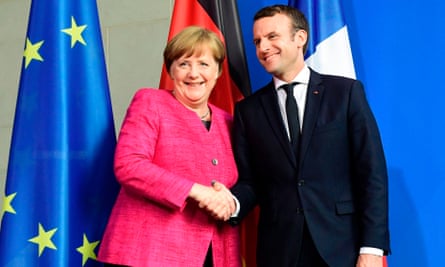What a difference a few months make. As 2017 opened, eurozone politicians still raw from the shock of the Brexit vote and Donald Trump’s presidential triumph were nervously awaiting elections in the Netherlands and France.
They feared that discontent would propel the populist wave into the heart of Europe and usher in far-right, anti-euro leaders. In the event, the predicted surge for Dutch populist Geert Wilders failed to materialise and in France, Front National candidate Marine Le Pen was decisively beaten by pro-EU centrist Emmanuel Macron.
Now, the economic picture for the currency union is looking brighter. Unemployment in the bloc is at its lowest for almost eight years and economic growth was 0.5% in the first quarter, well ahead of the UK’s 0.2%.
Business surveys suggest the new year momentum within the eurozone carried on in the second quarter. Based on one report, the flash eurozone PMI (purchasing managers’ index) survey from IHS Markit, growth was at a six-year high in May. The EU recently nudged up its forecast for eurozone growth this year to 1.7%, almost matching the 1.8% of 2016. It also expects unemployment to keep falling as the economic recovery finally spreads to all corners of the region.
Experts say it is no coincidence that the approval ratings of populists are fading as the economy strengthens. “Support levels for anti-establishment or populist parties have declined quite sharply over the past few months,” says Andy Cates at Nomura.
He sees a number of causes of the recent strength, including a revival in global growth; improved domestic demand; signs that capital spending is making a comeback; and sharp declines in youth unemployment. In the longer term there will be further support from member nations’ public finances being in better shape, giving governments more space to shore up the recovery, he adds.
Economists point out that the relationship between brighter economic news and diminishing popularity for anti-establishment parties works both ways. The decline of populism has in turn helped the economy. “It looks like confidence in the European economy is returning rather quickly,” says Bert Colijn of ING bank in Amsterdam. He says the brighter mood is down to the economic strength seen in official figures and surveys, and a change in the political atmosphere since the Dutch and French elections.
“There is a sense that we’ve turned a corner in terms of political risk. After Trump and Brexit there was a worry we would see more of this sentiment and this could be the big thing that topples the euro,” said Colijn. But he cautions against getting carried away with what he describes as “europhoria”. He see risks from Greece’s debt problems and from Italy, where unemployment remains high, particularly among young people. “It would be silly to think all problems are out of the way.”
Reinhard Cluse at UBS is also wary, pointing out that business surveys have tended to come in stronger than official growth figures: “We are cruising at a high altitude. But this optimism is not fully reflected in the hard data.”
Cluse expects the pace of growth in the eurozone to ease off in the second half of this year as higher inflation erodes household spending power and the European Central Bank starts to hint at taking away some of the stimulus of its massive electronic money printing programme. But that was no reason to be downbeat: “Although we cannot perhaps maintain the growth rates of the first half, a slowdown from that does not mean bad news. In relative terms, Europe looks good.”
Amid such optimism, here is a health check of five key eurozone economies, from Germany’s powerhouse to perennially troubled Greece.
Spain
GDP growth in 2016: 3.2%
GDP growth forecast for 2017: 2.8%
Unemployment: 18.2%
Youth unemployment: 40.5%
After a long downturn and a property crash, Spain has enjoyed one of the eurozone’s fastest rates of GDP growth and a robust rise in employment – even if a chunk of them are temporary jobs. Youth unemployment is still high by European standards but is down from more than 46% a year ago.
Exports have been driving Spain’s recovery, so strength in the rest of the eurozone and the world has helped. A rebound in consumer spending has provided a further fillip but rising inflation could dent that.
The housing market has also recovered. But one important source of support for property prices appears to be declining: no other nationality buys as much property in Spain as the British, and sales have slumped since the Brexit vote hit the value of the pound.

Italy
GDP growth in 2016: 0.9%
GDP growth forecast for 2017: 0.9%
Unemployment: 11.7%
Youth unemployment: 34.1%
The recovery in the eurozone appears to have largely passed Italy by, judging by the latest data. GDP rose just 0.2% in the opening quarter of 2017. The sluggish recovery from a recession that only ended in 2014 has taken its toll on living standards. While unemployment in the wider eurozone fell over the past year, in Italy it crept up. But youth unemployment is down.
Many economists feel Italy is the weak link in the eurozone and highlight risks that an election expected in early 2018 could usher in anti-establishment politicians like Beppe Grillo’s Five Star movement. Adding to worries about Italy’s potential to destabilise the eurozone, its debt levels remain high; it suffers from a marked north-south divide and its banking system is weighed down by bad debts.
Greece
GDP growth in 2016: 0.0%
GDP growth forecast for 2017: 2.1%
Unemployment: 23.5%
Youth unemployment: 48.0%
Greece has slipped back into recession, with two consecutive quarters of contraction underscoring its fragile state after years of deep spending cuts and political upheaval. Nonetheless, forecasters remain optimistic that it can start growing again in 2017.
Greece has the highest unemployment and youth unemployment in the eurozone, and households have been hurt by austerity policies pushed through to appease international creditors. More recently, sentiment has been hit by uncertainty about Athens’s ability to afford loan repayments that fall due in July after eurozone finance ministers meeting this month failed to agree a deal to unlock a tranche of bailout funds for Greece. Hopes now rest on talks in mid-June.
But economists feel the risks for the eurozone from Greece have receded since the peak of the crisis in 2012 and since 2015 when the anti-austerity party Syriza swept to power. “We are not where we were in 2015 and even then it didn’t feel like it [the Greek crisis] was going to take down the eurozone the way people feared in 2012 and 2013,” says Colijn at ING.

France
GDP growth in 2016: 1.2%
GDP growth forecast for 2017: 1.4%
Unemployment: 10.1%
Youth unemployment: 23.7%
Emmanuel Macron’s victory this month assuaged short-term fears about a rise of the far-right Front National and anti-euro sentiment generally. But commentators have been quick to warn that the country’s problems have not gone away. Reflecting the frustrations that turned many voters to political extremes, France has a relatively high youth unemployment rate, its overall jobless rate is more than double Germany’s and economic growth is expected to remain sluggish this year.
Germany
GDP growth in 2016: 1.9%
GDP growth forecast for 2017: 1.6%
Unemployment: 3.9%
Youth unemployment: 6.7%
A victory for Macron in France brought big relief to its major trading partner, Germany, where business sentiment has soared. A closely watched business survey by Germany’s Ifo institute last week showed confidence at its highest since records began in 1991.
The figures paint a bright picture for Europe’s largest economy and so far it appears to have suffered little fallout from Brexit or the election of protectionist Trump in another of its big trading partners. GDP growth accelerated in the opening months of 2017 on the back of robust exports, stronger state and consumer spending and a buoyant construction sector. That strength bodes well for chancellor Angela Merkel as she seeks a fourth term in September. Germany’s election is not seen to present the same risks to the EU project as other polls. Merkel’s main opponent is pro-European Social Democrat candidate Martin Schulz.
*Sources: GDP forecasts from European Commission outlook; unemployment figures from Eurostat (pdf)

Comments (…)
Sign in or create your Guardian account to join the discussion